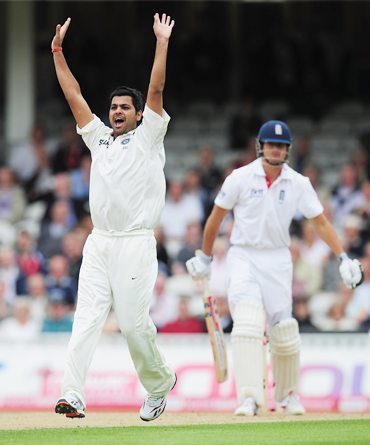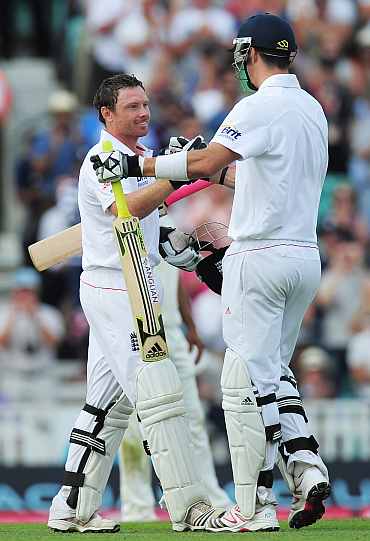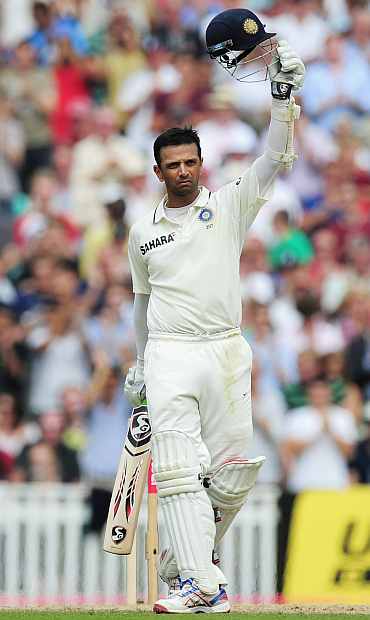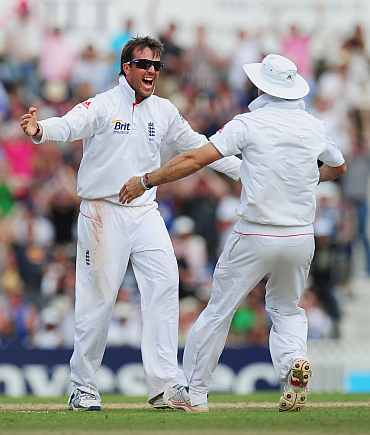Photographs: Getty Images Bikash Mohapatra
The whitewash is complete. It's time for an autopsy.
England's comprehensive innings and eight-run win over India at The Oval ensured the home team a 4-0 sweep, their first over India in 37 years, since winning 3-0 in 1974.
Chasing 291 just to make England bat again, the visitors collapsed to 283 all out and suffered their first whitewash in 11 years -- since they lost 0-3 Down Under in 1999-2000.
The margin of defeat in each of the four Tests was huge, and India's meek capitulation in the series shocking. The visitors' tame surrender made what was a high-profile series, to begin with, a one-sided affair.
While the bowlers paid the price for injury and overwork, it was an abject batting failure that witnessed the much-hyped line-up score 300 just once in eight innings. That ensured a cakewalk for the home team.
As the team's think-tank sits down to analyse where they went wrong, and what steps are to be taken prevent similar humiliation again, Rediff.com takes a look at the turning points in The Oval Test, and why the team couldn't save the match, and, consequently, the whitewash.
Day One: Indian bowlers failed to make most of the conditions
Image: Rudra Pratap Singh appeals unsuccessfully for the wicket of Alastair Cook on Day 1The fact that the Indian bowlers could not make use of the overcast conditions on Day One dealt a crucial blow to their prospects.
Going into the opening day, the visitors were aware they had lost their best bowler (of the series), Praveen Kumar, to an ankle injury. His replacement, Rudra Pratap Singh, had not played a Test in 28 months and not taken a wicket in the last four innings he had bowled.
Therefore, to expect instant results from him seemed a tad too far-fetched, and the team management's argument that he was picked to give the side the right balance seemed anything but convincing.
Andrew Strauss's decision to bat first, having called correctly, also surprised the visitors to an extent, considering the conditions at The Oval were overcast. MS Dhoni's bowlers were a tired lot and, true to form, did precious little in the first hour.
Ishant Sharma, S Sreesanth and R P could neither generate speed nor direction. There was no intent, no energy and, certainly, no extra effort on their part. Strauss and Alastair Cook were never really tested as they guided England to a comfortable 75 without loss at lunch.
Torrential rains meant no further play was possible in the day. India though had lost an opportunity to strike early.
Day Two: Bell-Pietersen partnership grinds India
Image: Ian Bell and Kevin PietersenThe second day was all about a record partnership -- one that laid the foundation for the eventual win.
Ian Bell scored 181 and Kevin Pietersen notched 175, and, in the process, put on a record 350 runs for the third wicket -- the highest partnership for the wicket for England at the venue, obliterating the 268 runs put together by Graham Thorpe and Marcus Trescothick against South Africa in 2003.
Their efforts helped England end the day on a mammoth 457 for three.
Of the two, Pietersen's was an authoritative innings. The 31-year-old played around with the bowling and helped himself to 27 boundaries. It was the South Africa-born player's eighth 150-plus score and ensured he would finish the series in the manner he had started it -- a knock as emphatic as that spectacular 202 not out at Lord's.
The Indian bowling, needless to say, was pedestrian. The fielders looked haggard.
The body language of the players gave a clear indication of the mental state they were in following three successive losses.
Day Three: Bell's double, England bowlers added to India's agony
Image: Ian Bell celebrates after completing his double centuryIt was a perfect team effort by England.
Ian Bell completed his maiden Test double hundred (235) -- a knock that marked personal gratification for the batsman, whose previous Test best was 199, against South Africa at Lord's in 2008.
The batsman also reached another landmark during his innings -- 5, 000 Test runs. The 29-year-old became the 21st England batsman, and 79th overall, to achieve the feat.
Bell's effort ensured England scored a whopping 591 for six in their first essay.
Even as India came out to bat there was some bad news in the offing: Gautam Gambhir had mild concussion, due to the fall he had had while attempting to catch Pietersen, and didn't come out to open. Rahul Dravid stepped in.
While Dravid survived the day, the wickets around him fell in a heap. Virender Sehwag, VVS Laxman, Sachin Tendulkar, Suresh Raina and Ishant Sharma fell one after the other as India ended the day on a paltry 103 for five.
The England bowlers had done a remarkable job, considering close to three hours had been washed out due to the wet weather.
Day Four: England bowlers nullified Dravid's century
Image: Rahul Dravid celebrates after scoring his centuryThe second session was the turning point on the fourth day.
Indian hopes had received a boost before lunch -- with the team scoring 115 runs for the loss of just one wicket. Dravid completed his 35th Test hundred -- and went past Sunil Gavaskar's 34. It was his seventh hundred against England. It was also the first time since 2002 that the batsman scored three hundreds in a series.
However, in the post-lunch session, the visitors lost four wickets for the addition of just 82 runs.
India finished with exactly 300 in their first essay, 291 runs adrift of the English total.
The home team wasted no opportunity in enforcing the follow-on and helped their cause further by accounting for Dravid, Sehwag and Laxman before close of play.
India finished the day on 129 for three. England had taken the first step towards victory.
Day Five: 'Sixy' Swann buried India
Image: Graeme Swann celebrates after picking a wicketAgain, it was the second session of the day that not only proved the turning point, but also ensured the match was over with more than a session left.
India had dominated the opening session, scoring 87 runs in 30 overs, without losing a wicket.
Resuming at 216 for three post-lunch, everything looked good for the visitors. There was no swing in the wicket -- it resembled an Indian dust bowl -- and both its batsmen, Sachin Tendulkar and Amit Mishra, seemed set to score big hundreds.
When Tendulkar was put down by Matt Prior (off Graeme Swann) on 85, it seemed that was all he needed to notch his 100th international hundred. However, despite getting no assistance whatsoever from the wicket, the English bowlers kept trying.
Their persistence was eventually rewarded when Swann had Mishra caught behind for 84, thereby ending a 144-run partnership for the fourth wicket. The second English success of the came in the next over by Tim Bresnan, when Tendulkar was given out leg before.
Suresh Raina was also dismissed early and soon after England took the second new ball. The writing was on the wall.
The day's first session was all about Indian resistance. The second was about an Indian collapse; the visitors lost their last seven wickets for just 21 runs, with Swann registering figures of six for 106 -- his 11th five-wicket haul in Tests but first against India.
England's dominance over India was complete.







Comment
article